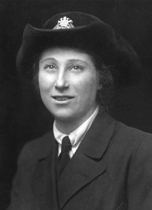The Gurdjieff Legacy Foundation Archives
Ethel Merston (1882–1967)

One of Gurdjieff's first students at the Prieuré was Ethel Merston, who remained until 1927 when she departed for India, where she met and studied with many of the seminal teachers and spiritual figures of her times. When in her 80s she wrote her life story—a task Gurdjieff gave his students during their development—giving a picture of life at the Prieuré with Gurdjieff, and her later experiences.
Born in late Victorian London to wealthy Jewish parents, Ethel Merston led a life of privilege in the unhappy household of a disharmonious upper middle-class family. Her mother rejected her from birth and obstructed the relationship with her father, creating a psychic wound with which she would work her whole life.
Through Maurice Nicoll, Ethel learned of Uspenskii's meetings to "disseminate the teaching of a Russian, George Ivanovitch Gurdjieff," and began attending them in 1921. At Gurdjieff's first London talk in February 1922, she was struck by "his silences and his piercing eyes."1
In August Ethel sought out Gurdjieff in Paris and asked if he would accept her as a student. He made no reply. "He was absolutely silent." The two of them sat in silence for a half hour. "He was weighing up whether to take me or not." The intensity increasing, she waited. Then Gurdjieff stood and said—"Come." He took her to his flat for lunch, and told her to go at once to the château where he was founding his Institute. Gurdjieff made her responsible for the garden and put her immediately to work. Ethel would come to have many encounters with Fritz Peters, who wrote about her as Miss Madison in Boyhood with Gurdjieff.
After Gurdjieff's car accident in 1924, Ethel recounts how shortly after Gurdjieff regained consciousness, though still in bed and having no memory, he began dictating the story of the redeemed Beelzebub. For the first two or three weeks of dictation he would say "'Take down.' 'I am being told.' 'I hear.' Only after recovering complete consciousness did he claim the writing as his, the book as his own."
Gurdjieff wrote in Russian and Armenian. He assigned Ethel to work with Thomas de Hartmann as one of the translators; they were both fluent in French, through which she would arrive at the English. Evenings in the salon Ethel would read the translated pages to all assembled, Gurdjieff sometimes stopping her to refuse a word. "If the sentence were an active one," she wrote, "then the endings and prepositions used had to be active and I learned which were active words and endings, which passive and which neutral. And this though Mr. Gurdjieff knew practically no English. But he could doubtless tell from the different vibrations of each word. Occasionally we even had to coin a word to satisfy him."
In 1927 she left the Institute, Gurdjieff remaining an important influence in her life. After moving to India she often visited her friend Sunyata—a "rare born mystic" Ramana Maharshi had said of him. In 1938 Ethel went to the ashram of Ramana Maharshi, whose eyes "twinkled and looked through you—though in a very different way from Gurdjieff's piercing gaze." She later went to live in the ashram and was with Bhagavan until his death in 1950. In her memoirs she relates a rare first person account of his death, and how he gave darshan even while the body was dying.
Ethel traveled for some time with Anandamayi Ma and witnessed the momentous meeting between her and The Mother at Pondicherry in 1952.
In 1959, on her last trip around the world, she reconnected in New York with old friends Jeanne de Salzmann, Madame Uspenskii, Olga de Hartmann and Peggy Flinsch, and was introduced to Lord John Pentland.
Returning to Ramanasramam, she built a house, where she died on March 19, 1967.
Notes
1. All references are from A Woman's Work with Gurdjieff, Ramana Maharshi, Krishnamurti, Anandamayi Ma & Pak Subuh (Fairfax, CA: Arete Communications, 2009) by Mary Ellen Korman, foreword by William Patrick Patterson.